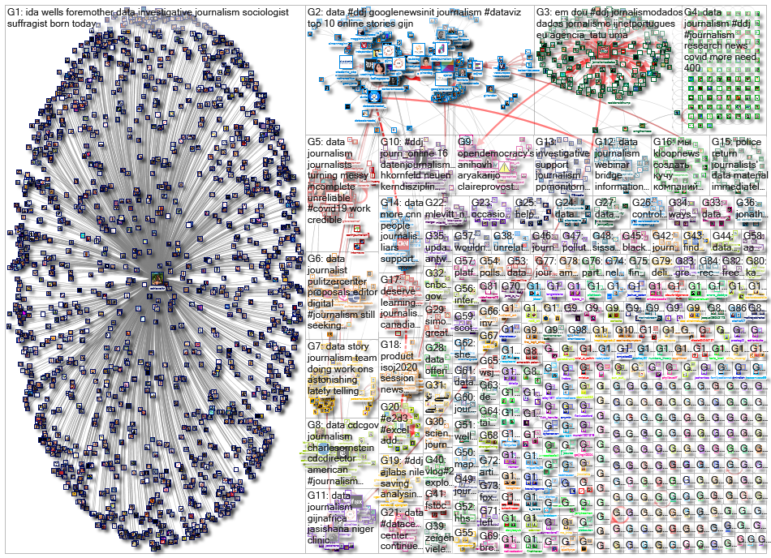How widespread is mask use in your country? Our NodeXL #ddj mapping from July 13 to 19 finds The New York Times mapping the odds of people encountering other mask wearers in the United States, two university professors quantifying the number of interruptions a parent suffers working from home, the Committee to Protect Journalists talking to data journalists about the struggles of reporting on COVID-19, and openDemocracy documenting mistreatment of women in labor since the pandemic began.
Mask Use in the United States
Do people in your area wear masks when they are outside? The New York Times mapped the odds — if you encountered five people in a given area in the US — that all of them would be wearing masks. The data is from 250,000 responses collected between July 2 to 14, and comes from a survey conducted by the global data firm Dynata at the request of the NYT.
Masks are critical to controlling the #coronavirus.
According to @CDCDirector, if everyone wore a mask for the next 4-8 weeks, the U.S. could control the epidemic.
Where are most people wearing masks? Where are they not? Check out this interactive map👇https://t.co/q25QHHPbvi
— HarvardGlobalHealthInstitute (@HarvardGH) July 17, 2020
Measuring Interruptions While Working From Home
During the pandemic, many parents have had to adapt to the realities of working from home while parenting, and it hasn’t been easy. Profs. Suzanne M. Edwards and Larry Snyder got so frustrated by all the interruptions to their professional work that they quantified it. The disruptions they counted included their children’s requests for help with homework, questions about chores and snacks, check-in hugs, and tech support. They found that on average, a parent on childcare duty was interrupted 15 times per hour.
"The average length of an uninterrupted stretch of work time was three minutes, 24 seconds." That sounds about right. https://t.co/kIbgHhjsWY
— Stephanie Mencimer (@smencimer) July 13, 2020
Data Challenges of Covering COVID-19
From insufficient data to governments deliberately restricting access to information, covering the coronavirus pandemic has been a challenge, data journalists told the Committee to Protect Journalists. Five journalists — Darren Long, Rodrigo Menegat, Mariano Zafra, Allison McCann, and Denise Hassanzade Ajiri — shared how they had used creativity, collaboration, and hidden sources to illuminate COVID-19’s impact.
Data journalists reporting on China, Brazil, Iran, the U.S., and Spain reveal the enormous undertaking of locating reliable coronavirus figures. By @RRedelmeier and Coral N. Negrón Almodóvar: https://t.co/4qcnGUYAZP
— NaomiZeveloff (@NaomiZeveloff) July 15, 2020
Childbirth Rights During the Pandemic
OpenDemocracy has been documenting cases of abuse and mistreatment of women in birth labor around the world since the pandemic started. Their map displays cases in at least 45 countries so far. They welcome help to add to their findings, and are also offering a webinar today (Thursday July 23) to discuss what they’ve uncovered with their forensic work into women being denied essential services or being treated in ways that breach the World Health Organization’s guidance.
Extremely important work:
Since the #COVID19 pandemic started, @openDemocracy has been documenting cases of abuse and mistreatment of women in labour around the world. Explore their findings – and help add to them:https://t.co/yndzPuDwQs
— Gauri van Gulik (@GaurivanGulik) July 21, 2020
US Data on COVID-19
The Brown Institute for Media Innovation, a collaboration between Stanford University’s School of Engineering and Columbia Journalism School, launched Documenting COVID-19, a repository of searchable local, state, and federal documents in the US related to the pandemic. The data is obtained through state open-records laws and the federal Freedom of Information Act.
A new project, @19Documenting, will help newsrooms get the Covid-19 data that states might rather keep hidden https://t.co/13jaV7F4zl
— Nieman Lab (@NiemanLab) July 13, 2020
India’s Low Coronavirus Death Count
India’s confirmed coronavirus toll has surpassed one million cases, joining a “club” that now comprises the US and Brazil. However, India’s death rates from the virus are mysteriously low compared to the other two nations. The Washington Post examines theories and factors that may have contributed to the low death rate.
We dug into India’s mysteriously low coronavirus fatality figures. We found both misreported deaths and signs of “excess” unexplained deaths linked to the pandemic /1 https://t.co/VK0yJrU9S5
— Joanna Slater (@jslaternyc) July 18, 2020
Trump Profiting from Public Service
Karen Tumulty, a columnist who writes about national politics for The Washington Post, wrote an Op-Ed about how Donald Trump’s private businesses are profiting from his public service. According to the Center for Responsive Politics, Trump’s presidential campaign and its related committees have steered US$2.6 million of donors’ money to Trump’s family-owned properties and businesses.
In just two days, @realdonaldtrump’s campaign pumped $380K into Trump’s private business, in 43 separate payments. Trump Org says this was for a weeklong “donor retreat,” held in early March at Mar-a-Lago.
Campaign donations turned into private revenue for POTUS pic.twitter.com/1kf39vAqkt— David Fahrenthold (@Fahrenthold) July 17, 2020
Mapping Istanbul’s Health Services
Eren Janberk Genç, a student at Boğaziçi University, examined the distribution of healthcare services across Turkey’s largest city, Istanbul, in an attempt to find patterns and possible inequalities in the city’s health services.
So, i've done it again! I just published my second open data analysis project. This time, i took a look at the distribution of healthcare institutions in Istanbul in an attempt to discover any underlying patterns and inequalities.https://t.co/oqyhP4SKw5
— Eren Janberk Genç (@ejgenc) July 13, 2020
German Parliament Scraper
Looking for German parliamentary data and a quick way to scrape it from online? Data journalist Katharina Brunner shared a scraper, written in Python, for Parlamentsspiegel, a site that collects the federal parliamentary documentation of Germany.
Der Parlamentsspiegel (https://t.co/QHXyG39f30) sammelt die Drucksachen aus allen Landesparlamenten. Es gibt keine API, nicht mal saubere Metadaten. Wer die Sachen trotzdem braucht, der hilft vielleicht mein Scraper und Metadaten-Parser: https://t.co/0yakDMREiG #ddj #opendata
— Katharina Brunner (@cutterkom) July 14, 2020
Data Visualization Workshop
5W Consulting, an information design company, is offering a four-day information graphics and data visualization workshop online in September. The instructors include the 5W founders Juan Velasco, previously the art director for National Geographic, and Samuel Velasco, former art director at Fortune magazine. The early bird price is US$500.
OPEN FOR REGISTRATION: Our next 5W Academy workshop via Zoom. By the founders of award-winning studio 5W Infographic. Register soon and get $150 off. https://t.co/r0e7DWCHEb https://t.co/pjRha8quVn #Infographics #dataviz #datavisualization #motiongraphics #ddj #informationdesign pic.twitter.com/9ppcRA6cN4
— 5W Infographics (@5Winfographics) July 16, 2020
Thanks again to Marc Smith of Connected Action for gathering the links and graphing them. The Top Ten #ddj list is curated weekly.
 Eunice Au is GIJN’s program coordinator. Previously, she was a Malaysia correspondent for Singapore’s The Straits Times, and a journalist at the New Straits Times. She has also written for The Sun, Malaysian Today, and Madam Chair.
Eunice Au is GIJN’s program coordinator. Previously, she was a Malaysia correspondent for Singapore’s The Straits Times, and a journalist at the New Straits Times. She has also written for The Sun, Malaysian Today, and Madam Chair.

